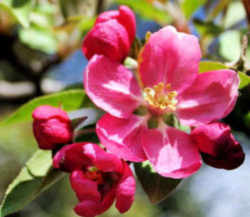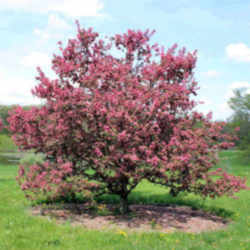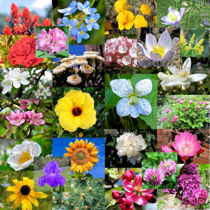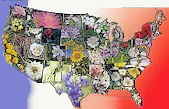Michigan State Flower
Apple Blossom

(Pyrus coronaria)
Adopted on April 28, 1997.
In 1897, the APPLE BLOSSOM. (Pyrus coronaria) was designated the state flower as Michigan legislators, feeling that "a refined sentiment" called for the naming of a state flower, designated the apple blossom, (Pyrus coronaria.) Joint Resolution 10 of that year noted "one of the most fragrant and beautiful flowered species of apple, the pyrus coronaria, is native to our state." Legislators also proudly declared that "Michigan apples have gained a worldwide reputation." A century later, Michigan ranks second in the nation in apple production.
Michigan State Flower: Apple Blossom

"Crab" derives from a Norse word meaning scrub or rough, but the true ancestry of the original native species of crab, Malus sylvestris, has been lost in time. We think it was first cultivated by Neolithic cultures in Europe and traces of its existence near settlements from slightly later periods have been recorded - mainly through remains of apple pips in charcoal.
Apples and crabapples are in the rose family, Rosaceae, in the genus Malus. Crabapples are differentiated from apples based on fruit size. If fruit
is two inches in diameter or less, it is termed a crabapple. If the fruit is larger than two inches, it is classified as an apple.
Originally, the group of trees known as crab apples included only the most sour-fruited seedlings from orchard varieties and also native species of
apple, but now this group contains all varieties of Malus except those considered to be orchard varieties.
Depending on the cultivar and spring temperatures, full bloom could occur as early as late April or delay until mid-May. Flowers are classified
as single (five petals), semi-double (six-ten petals), or double (more than 10 petals). Double-flowering crabapples retain their flowers longer than
other types, but fruiting is usually sparse.
Blossom colors range from pearly white through delicate pinks to a deep red. There are even cultivars with coral or salmon colored flowers.
The Apple Blossom
100 Years As The State Flower
(And The Story of a Pair Of Intriguing
People Who Helped Make It So)
One hundred years ago, the scent of fresh apple blossoms filled the state Capitol. Legislators took notice. They named the apple blossom Michigan's
state flower.
April 28, 1997, marked the 100th anniversary of this official designation.
Two citizens had eminent roles in the story behind this tribute. One was a northern Michigan legislator with pioneer roots in Michigan pre-dating statehood
in 1837. The other was a distinguished 63-year-old woman who pushed a wheelbarrowful of apple blossoms down Lansing's Capitol Avenue and made the Capitol
atmosphere fragrant.
The language of the 1897 resolution naming the state flower suggests that little has changed in 100 years. It pointed out that "our blossoming apple
trees add much to the beauty of our landscape" --a still-true statement as 58,000 acres of commercial apple orchards and thousands of home-grown apple
trees attest. The aroma and delicate beauty of pink and white apple blossoms help make springtime in Michigan a special experience.
The resolution also noted that "Michigan apples have gained a worldwide reputation." This long-running renown is as strong as ever. Michigan now produces
around a billion pounds of apples each year, making the state not only a national, but a global leader.
The man who introduced this resolution was William Harris of Norwood, a shoreline community south of Charlevoix where Grand Traverse Bay merges into
Lake Michigan.
Harris migrated from New York state with his parents as a four-year-old in 1836 and settled near Battle Creek in Michigan Territory. Thirty years later
he moved north with his young family to open a boarding house for dock and sawmill workers in Norwood. Subsequently he was a postmaster and longtime
township supervisor before being elected to the state House of Representatives. He became so inspired by the beauty of a large apple orchard across
from his home that he decided such lovely blossoms should be adopted as the state flower.
His resolution, introduced February 9, 1897, meandered through the legislative process for a couple of months. The final vote still hadn't been taken
when apple trees burst into bloom around mid-April, well ahead of normal, in the southern part of the state.
One colorful site during this early spring was the yard of Anna Eliza Woodcock, two blocks north of the Capitol. She later told a reporter she knew
the vote on the state flower was due and was so taken by the beautiful new blossoms on her Snow apple trees that she decided to cut off a few and trundle
them in a wheelbarrow to the Capitol. There she located House Speaker William Gordon's desk and chair and decorated them with her blossoms. Both the
House and Senate agreed that naming the apple blossom as the state flower was a good idea. The process was completed April 28.
Harris acquired the nickname "Apple Blossom William" for his role. Mrs. Woodcock later learned how to make silk apple blossoms, enhancing her own reputation
as "the apple blossom lady," and practiced her art into her 90s.
A century after passage of the 1897 resolution, Michigan residents can still be gratified that the state has such a flood of apple blossom beauty each
year to signal a new growing season and a pending bountiful harvest of apples by the next autumn.
Source: Michigan Apple Committee
Michigan Law
The law designating the apple blossom as the official Michigan state flower is found in the Michigan Compiled Laws, Chapter 2, Section 2.11.
Michigan J.R. 10 of 1897
STATE FLOWER
J.R. 10 of 1897
A JOINT RESOLUTION to designate and adopt a state flower.
2.11 State flower.
WHEREAS, A refined sentiment seems to call for the adoption of a state flower; and
WHEREAS, Our blossoming apple trees add much to the beauty of our landscape, and Michigan apples have gained a worldwide reputation; and
WHEREAS, At least one of the most fragrant and beautiful flowered species of apple, the pyrus coronaria, is native to our state; therefore
Resolved by the Senate and House of Representatives of the State of Michigan, That the apple blossom be and the same hereby is designated and adopted
as the state flower of the state of Michigan.
History: 1897, J.R. 10, Imd. Eff. Apr. 28, 1897 ;-- CL 1897, 1755 ;-- CL 1915, 1096 ;-- CL 1929, 133 ;-- CL 1948, 2.11
Taxonomic Hierarchy: Apple
Kingdom: Plantae - Plants
Subkingdom: Tracheobionta - Vascular plants
Superdivision: Spermatophyta - Seed plants
Division: Magnoliophyta - Flowering plants
Class: Magnoliopsida - Dicotyledons
Subclass: Rosidae
Order: Rosales
Family: Rosaceae - Rose family
Genus: Malus Mill. - apple
Species: M. domestica -
Subspecies: Malus coronaria var. coronaria
State Floral Emblems








